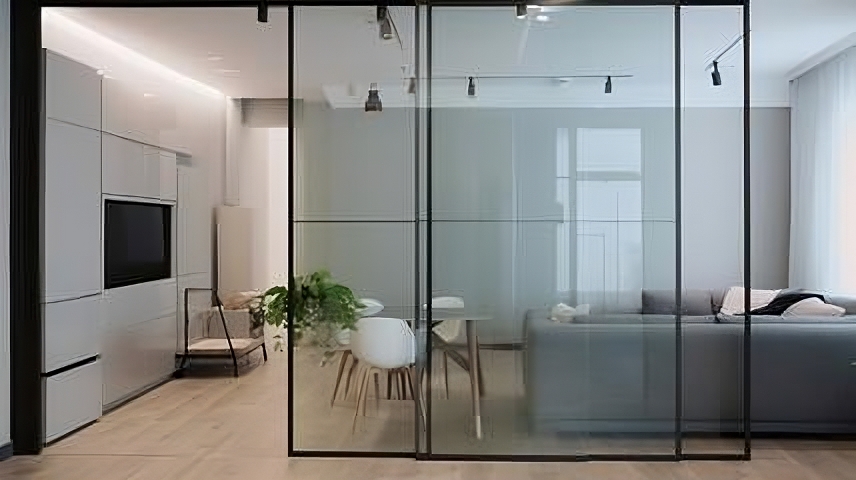
Sliding partition doors and walls are becoming a practical choice in both homes and offices across the UK. In particular, as living and working habits evolve, more people are seeking flexible layouts that adjust to changing needs without the hassle of permanent construction or renovation.
This guide explores how sliding partitions can help define space, improve comfort, and support daily routines. In it, you’ll find creative layout ideas, an overview of popular materials and mechanisms, and useful advice to help you choose and install a system that works for your space, design preferences, and practical needs.
Why Choose Sliding Partition Doors and Walls?
Sliding partitions are compact and efficient. They offer a straightforward way to separate or link rooms without needing extra floor area or structural modifications. In homes, they make it easier to manage multifunctional spaces like turning a living room into a quiet study or separating a dining area from a kitchen. In workspaces, they help organise meeting areas, team zones, or client-facing rooms without fixed walls.
Aside from their practical use, sliding partitions also contribute to interior design. Moreover, with options in glass, timber, metal, and composite materials, they can match a wide range of styles. The clean, linear design of a sliding system often suits contemporary spaces; however, it can also be adapted to complement softer or more classic finishes.
Types of Sliding Partition Doors & Walls
1. Sliding glass partition doors
Glass panels are particularly well suited for rooms where you want to let in more light while maintaining visibility between zones. For this reason, they’re often used in home offices, lounge areas, or internal corridors in offices. Depending on your need for privacy, options include clear, frosted, or textured finishes. Importantly, always look for toughened or laminated safety glass that meets UK regulations.
Read More: Sliding Glass Doors
2. Wooden sliding partition doors
Wooden partitions, on the other hand, add a natural and comfortable finish to a space. In addition, they help soften hard surfaces and are especially effective in rooms where a more grounded, calm atmosphere is needed. Available options range from light-toned oak to dark walnut or painted finishes, with both solid and slatted designs to choose from.
3. Acoustic sliding partition walls
When noise is a concern, sound-rated partitions are a strong choice. These systems are designed with insulated cores or sealing strips that reduce sound transfer between rooms. They’re often used in meeting rooms, open-plan offices, or family homes where separate activities take place in close proximity.
Learn More: Acoustic Glass
4. Customised sliding partitions
Custom-fitted partitions are ideal for rooms with unusual shapes, size restrictions, or specific design goals. From extra-wide panels to printed graphics or colour-matched finishes, these systems give you the freedom to solve layout challenges with a tailored approach.
Innovative Sliding Partition Ideas for Homes
1. Home-work areas: Sliding partitions can turn part of a living room or spare bedroom into a quiet work area. When closed, they help reduce distractions; when open, they allow the space to return to shared use.
2. Dividing living and dining spaces: For homes with large open areas, sliding doors help define where eating, relaxing, or working happens. You can keep the panels open when entertaining or close them when needed.
3. Wardrobes and storage zones: Use sliding doors to section off wardrobes, laundry areas, or household storage. They provide a cleaner look than open shelving and help reduce visual clutter.
4. Ensuite bathroom access: A single sliding door between a bedroom and bathroom saves space and adds convenience, especially in flats or compact homes where swing doors may take up too much room.
Smart Sliding Partition Ideas for Offices
1. Flexible meeting rooms: Use wall-mounted sliding partitions to open or close meeting areas as needed. This setup is useful for smaller teams or when meetings vary in size and purpose.
2. Project zones or breakout areas: Sliding systems allow offices to create temporary team spaces within larger rooms. This supports focused work without isolating the group.
3. Reception and waiting spaces: A sliding partition provides discretion in reception areas by quickly and efficiently closing off staff-only sections when needed.
4. Shared desks and quiet rooms: Instead of building fixed walls, sliding panels can create quiet spaces for calls or focused work, while still allowing those areas to be easily rejoined with the main floor.
Factors to Consider When Choosing Sliding Partitions
1. Space and layout considerations
Start with a close assessment of the space. Measure wall-to-wall and floor-to-ceiling clearance, and determine where the panels will slide; across the wall, into a recess, or along a ceiling track. Think about how often you’ll open or close the partition and how it will interact with existing furniture, windows, and light fixtures.
2. Material selection and durability
Different materials offer different performance benefits. Glass adds visual transparency and is ideal for light-sharing rooms. Timber and composite panels offer more visual coverage and sound control. For long-term reliability, choose materials that can withstand daily use without warping, scratching, or loosening over time.
3. Acoustic and privacy requirements
If the goal is to create a private room within a shared space, select panels with acoustic cores or edge seals that help reduce sound transfer. For visual privacy, consider frosted or opaque finishes, or solid panels. This is especially important for home offices, bedrooms, or quiet zones in shared work environments.
4. Installation complexity and costs
Surface-mounted systems are relatively straightforward, while full-height, ceiling-hung, or acoustic sliding walls require technical knowledge, precise fitting, and structural consideration. Professional installation ensures safety, smooth function, and product longevity; cutting corners here often leads to issues down the line.
5. Maintenance and ease of use
Opt for sliding systems with high-quality track mechanisms, corrosion-resistant fittings, and easy-to-clean panel surfaces. The smoother the hardware, the more reliable the system will be over time. Choose a design that’s low maintenance and easy to operate daily, especially in high-use zones like living rooms or offices.
6. Shape
While most sliding partitions are rectangular, curved or L-shaped layouts are possible with custom configurations. If you have an unconventional wall line, angled ceiling, or corner-to-corner setup in mind, speak with us directly. We’ll assess the shape and structural needs and recommend a tailored system that works.
Sliding Partition Installation Tips
DIY vs professional installation
While DIY exist, they are often limited in scope, less durable, and prone to errors if not installed with precision. Misaligned tracks, uneven panels, and inadequate wall support are common DIY issues. For full-size partitions, ceiling tracks, glass systems, or anything glass partitions related, we strongly recommend using a professional installer. At Kova Partitions, we handle complete setup from site visit to final fitting and ensure everything complies with safety and performance standards.
Common Installation Challenges and Solutions
1. Uneven walls or ceilings can throw off-track alignment. Our installers use precision lasers and custom brackets to compensate.
2. Heavy or large panels require special handling and reinforced fixings. Our team has the tools and training to install them safely.
3. Structural load issues may prevent certain ceiling-hung installations, this is why we always conduct a pre-installation site check to assess what’s feasible.
4. Access limitations like narrow stairwells or tight hallways can affect how the panels are delivered and fitted. This is why we plan logistics in advance.
Quick Step-by-Step Overview of Our Installation Process
1. Site visit & measurement: We assess dimensions, wall structure, and panel movement path.
2. System preparation: Track systems, panels, and accessories are prepared based on your layout.
3. Track installation: Tracks are mounted accurately, ensuring level alignment and smooth glide.
4. Panel fitting: Panels are lifted into place, adjusted, and tested for seamless movement.
5. Final inspection & handover: We walk you through functionality, cleaning tips, and aftercare.
FAQs
The cost depends on the type of system, materials used, and level of customisation. Glass and acoustic panels tend to cost more than basic timber or composite options, especially when full-height or ceiling-mounted. That said, there are both entry-level and premium solutions available, making it possible to find a system that suits most budgets.
.
Yes. Acoustic sliding partitions are designed with insulation layers or edge seals that help minimise sound transfer between spaces. They’re particularly useful in offices, shared living areas, or home studios where noise control is essential.
Glass, timber, aluminium, and composite panels are all popular choices. Glass is ideal for maximising light; timber adds warmth and texture; aluminium offers strength without extra weight; and composite materials balance durability with ease of maintenance. The best material depends on how and where the partition will be used.
Keep tracks clean and free of debris, clean panels with non-abrasive products, and lubricate sliding mechanisms as needed to ensure smooth movement. Periodic checks for loose fixings or worn components will help extend the life of your system.
In most cases, internal sliding partitions do not require planning permission in the UK. However, if your property is listed, part of a conservation area, or you’re altering a structural wall, it’s important to check with your local planning authority before proceeding.













